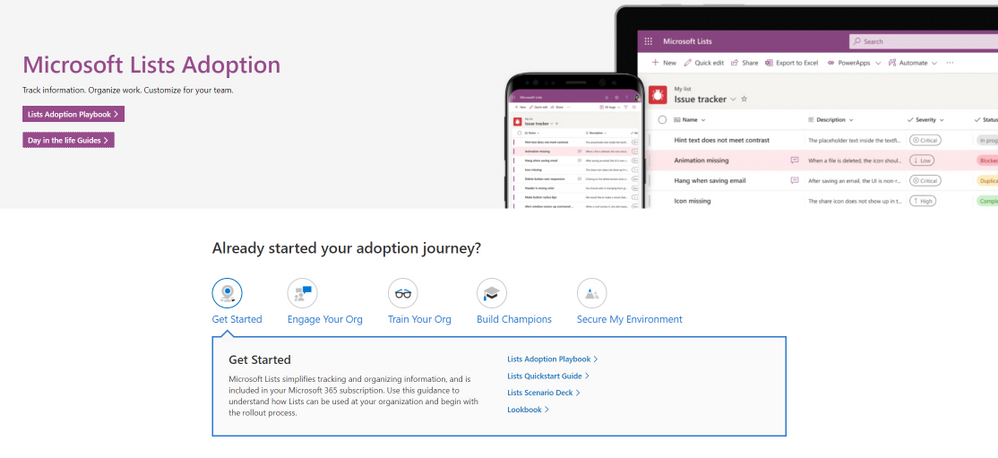
by Contributed | Jan 26, 2021 | Technology
This article is contributed. See the original author and article here.
What’s more fun than adopting Microsoft Lists at your organization? Leveraging prepared resources from Microsoft to help scale your Lists adoption – of course!
Lists is available 100% worldwide across all commercial, government, and education plans. Within Microsoft 365, Lists enables intelligent information tracking, with features to make organizing simple, smart, and flexible. And now that it’s here, it’s time to adopt it – at scale – across your entire organization. And we’re here to help.

Screenshot of the new Microsoft Lists adoption center within adoption.microsoft.com.
Visit the new Microsoft Lists adoption page – your hub of resources to help increase Lists awareness and usage in your organization, including:
- Adoption playbook: Review best practices for the entire adoption process, from recruiting champions and building out scenarios to growing awareness and running training.
- Day-in-the-life guides: Want to know how Lists is being used by Product Managers, Human Resources, Marketing, and Educators alike? The Lists Day in the Life Guides bring different use cases to life through a diversity of roles, scenarios, and industries to show how your organization can fully take advantage of Lists.
- Quickstart guide: If you’re ready to start playing around with Lists, the Quickstart Guide is your map for navigating the basic interface and features of the app, both standalone and integrated in Microsoft Teams.
- Adoption Templates: Begin your Lists rollout already equipped with a folder of email, flyer, and announcement templates, all written and designed to show off the main features of Microsoft Lists.
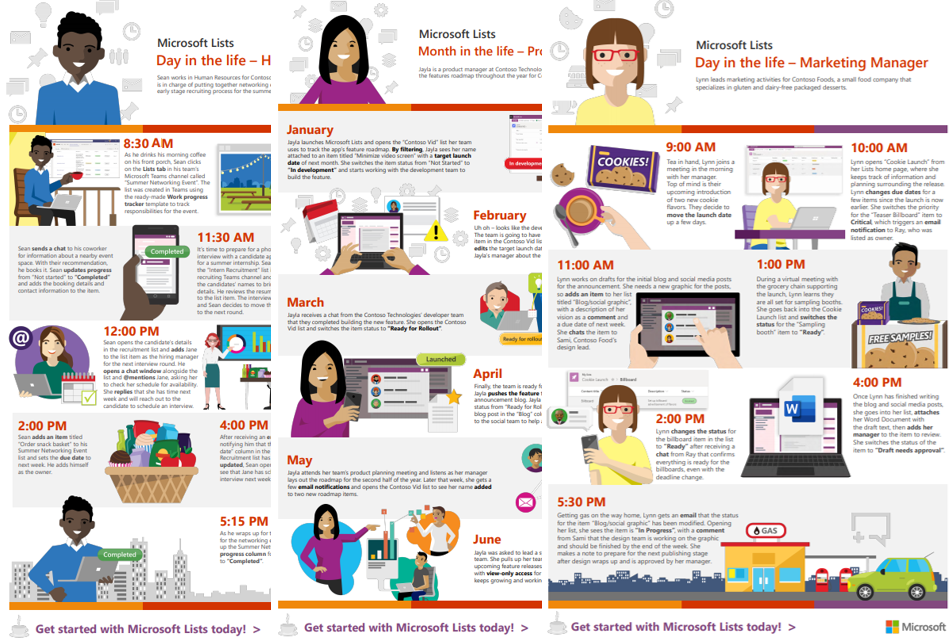
Screenshot of the Lists Day in the Life flyers within adoption.microsoft.com.
Additional resources
In addition to adoption guidance, you can learn more about Microsoft Lists and the rest of the Microsoft 365 collaborative portfolio:
- Microsoft Lists help and ‘how to’: Step-by-step guidance on how to use Lists – support articles and video tutorials.
- Lists resource center: Customer stories, blogs, podcasts, demos, and videos.
- Collaborative Work Management Demo: Guided Microsoft 365 walk through showcasing solutions across Planner, Tasks, Lists, OneDrive, and Sharepoint – to help you organize, share, and track business.
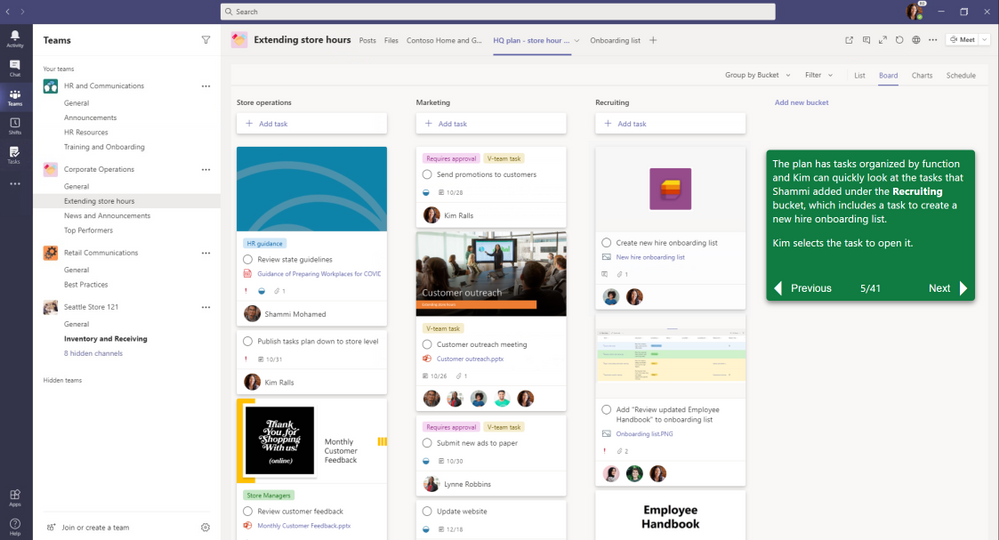
Screenshot of the Collaborative Work Management Guided Simulation.
Start today. Implement a few key scenarios – like an issue tracker, an internal event schedule, or a new hires dashboard. The above will help accelerate the ‘what’ and ‘how’ so you can get more done with Microsoft Lists.
Happy tracking!
Andrea Lum, product manager – Microsoft
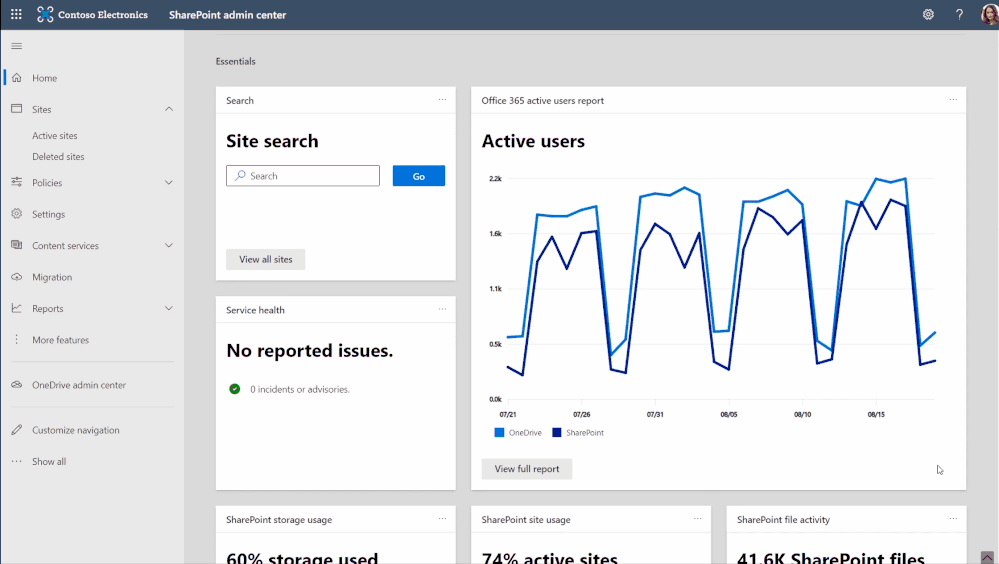
by Contributed | Jan 26, 2021 | Technology
This article is contributed. See the original author and article here.
OneDrive and SharePoint surpassed over 200 million monthly active users in 2020. This was an exciting development for us highlighting a key trend, consistent over the last few years and especially this past year, that the need for content collaboration is becoming more and more predominant for all organizations.
As we continue to power innovative experiences across Microsoft 365, we also realized that now, more than ever, admins need increased centralized control over content across the organization. Aligning to our coherence and modernization efforts, we are working hard to unify these experiences by bringing consistent design, naming conventions, look and feel to enable a smoother admin experience across the Microsoft 365 admin suite. And today we’re happy to announce that the OneDrive and SharePoint admin centers are converging into one, giving you holistic control and streamlining the admin experience.
What does this consolidation of the OneDrive and SharePoint admin centers mean?
With the new integrated admin center, you can manage everything at an organizational level all in one place: control internal and external sharing, set user access controls, manage default storage limits, enable user device notifications, specify retention policies, and manage sync controls for OneDrive. We’ve also improved the user interface to provide a more consistent experience and support Web Content Accessibility Guidelines (WCAG) 2.1 compliance, enhanced reporting, and added the Global Reader admin role, which provides a read-only view of SharePoint admin center. When you assign the Global Reader role to an admin, they can view—but not edit—all administrative features and settings in all Microsoft 365 admin centers, which helps you delegate admin responsibilities more efficiently.
You’re familiar with the SharePoint admin center homepage, where you can add widgets and personalize your dashboard. Now, you can enhance your homepage experience by accessing visual, actionable OneDrive cards such as OneDrive usage and OneDrive file activity, along with your SharePoint cards showcasing storage and site usage. This enables you to quickly see OneDrive activity for files that have been viewed/edited, synced, and shared internally or externally.
 Examine OneDrive usage and activity along with SharePoint storage and site usage. along with SharePoint
Examine OneDrive usage and activity along with SharePoint storage and site usage. along with SharePoint
These updates would be rolling out throughout February.
Setting up sync and retention
From the “Settings” page, you can easily drill into the widget to control how files sync in OneDrive and SharePoint. You have the option to show the Sync button on the OneDrive website, allow syncing only on devices joined to specific domains, and if you want to block upload of specific files types (e.g., .pst or video files), you can do so, all in one place. In addition, if you notice storage running low for OneDrive users, you can also easily adjust the default storage limit. When a user leaves the organization for any reason, you can also set a default retention period for their OneDrive and SharePoint content.
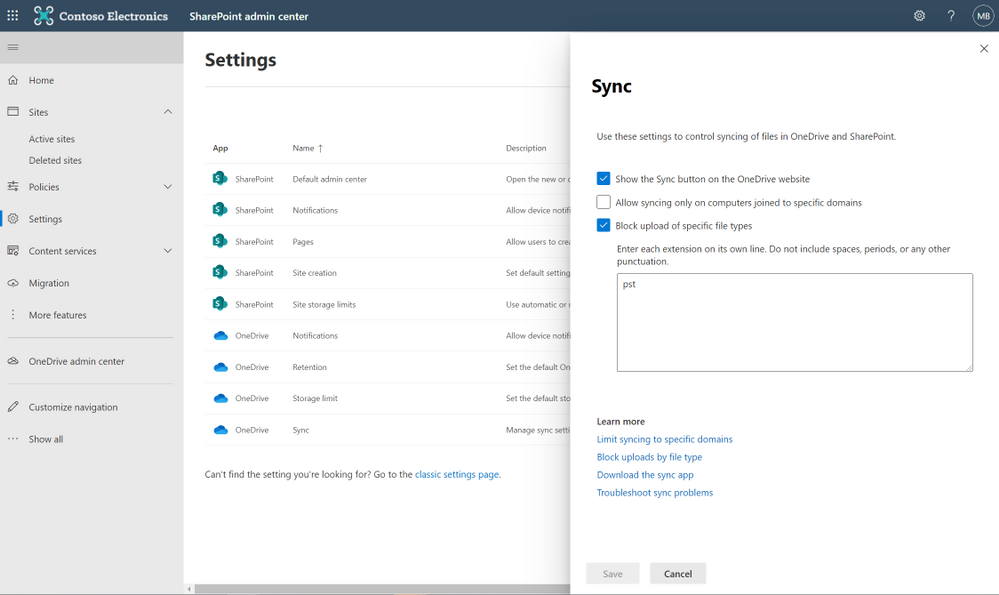 Set up storage limit, sync, retention, notification controls for your users.
Set up storage limit, sync, retention, notification controls for your users.
Managing sharing and access control
We want to ensure admins the visibility and control they need to avoid accidental data leaks without preventing their users from sharing necessary content. Now you can control how users across your organization share files externally and internally in both SharePoint and OneDrive from one page granting controls that are least or most permissive. You can limit external sharing by domain or security group for both SharePoint and OneDrive, which is helpful if you want to limit or prevent sharing with people at certain external organizations.
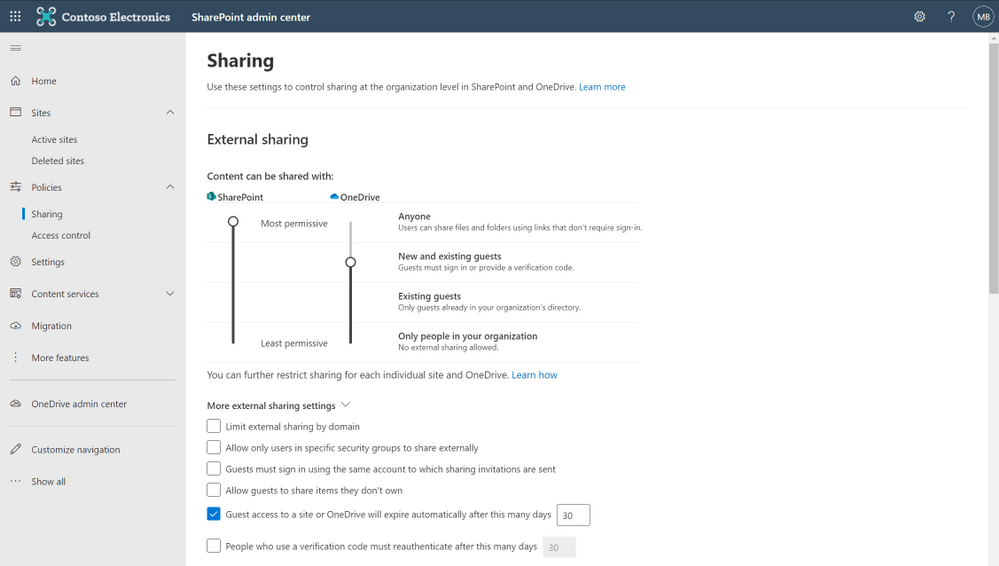 Manage internal and external sharing via the SharePoint admin center.
Manage internal and external sharing via the SharePoint admin center.
You can also specify the type of link that’s selected by default when people share files in SharePoint and OneDrive: anyone, people only inside the organization, or specific people. You can also set the default permission to either view or edit. This way, users can’t accidently share information with anyone outside the organization or externally share content that is meant for internal use only.
In addition, you can set expiration policies to ensure that external users won’t retain access to your content indefinitely. These policies can also prompt people in your organization to periodically review who they’re sharing files with. You can also easily revoke access that was previously granted.
Along with sharing controls , admins can also monitor how their organizational control is accessed. Admins can easily limit or block access to SharePoint and OneDrive content based on device or network location. You can set this across the organization, or for specific users, sites, or security groups. Limiting access enables users to remain productive if they’re working from a non-corporate device or from a remote location without a trusted network. With limited device access, users can access files through the browser only, and you can also set options for editing or view-only. When you’ve configured a location-based policy to restrict access from outside a specific network boundary, users cannot access content from any device if they are outside the network boundary.
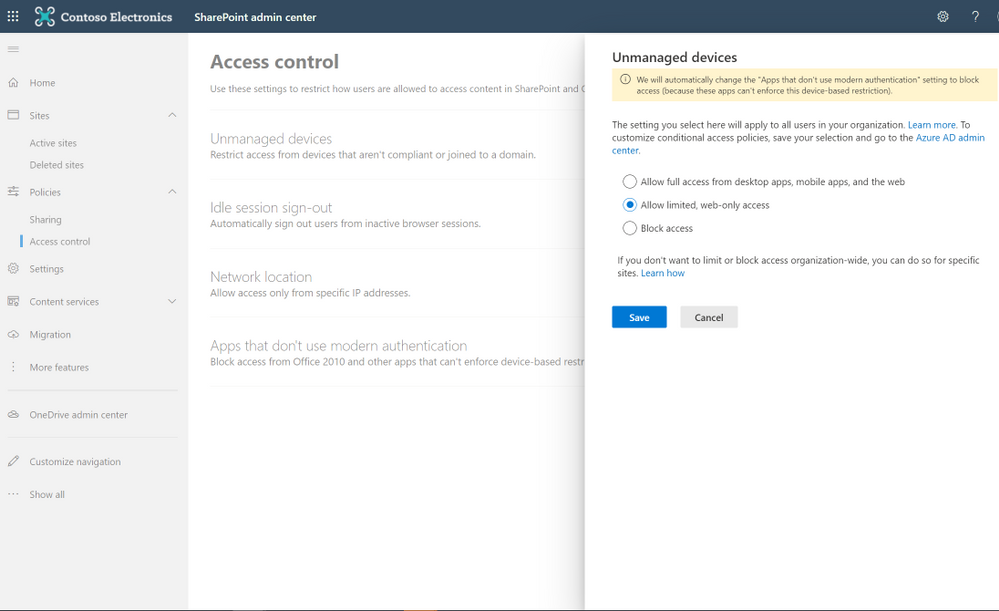 Set data access controls for your users
Set data access controls for your users
Learn more about the new SharePoint admin center and how you can help manage sharing in OneDrive for a better together experience.
Also, check out this month’s Sync Up episode to learn more about the consolidation from the experts .
https://html5-player.libsyn.com/embed/episode/id/17580788/height/90/theme/custom/thumbnail/yes/direction/backward/render-playlist/no/custom-color/f99400/
As you can see, we continue to evolve OneDrive as a place to access, share, and collaborate on all your files in Microsoft 365, keeping them protected and readily accessible on all your devices, anywhere.
You can stay up-to-date on all things via the OneDrive Blog and the OneDrive release notes.
Check out the new and updated OneDrive documentation.
Take advantage of end-user training resources on our Office support center.
Thank you again for your support of OneDrive. We look forward to your continued feedback and hope to connect with you at Ignite or another upcoming Microsoft or community-led event.
Thanks for your time reading all about OneDrive,
Ankita Kirti – Product Manager – OneDrive | Microsoft

by Contributed | Jan 26, 2021 | Technology
This article is contributed. See the original author and article here.
 On January 21st HLS Blog carried a special webcast covering the nursing hackathon that delivered innovative solutions designed to reimagine care delivery.
On January 21st HLS Blog carried a special webcast covering the nursing hackathon that delivered innovative solutions designed to reimagine care delivery.
The Reimagine Care Delivery Developer Challenge (virtual hackathon), presented by: Allscripts, MATTER, Microsoft and ARC (Sheba Medical Center) was held in December 2020 and the competition was stellar! The “entry solutions” were all designed to create the EHR of the future, to reduce the burden on nurses. During this recorded session 2 of the judges, Kathleen McGrow, RN, CNIO, Microsoft and Paul Minton, RN, VP Solutions Management, Allscripts, presented on the competition and the finalists. Also, joining them was the Hackathon winner – DeepScribe (Matthew Ko, Co-founder and COO), who highlighted how their innovative solution will be bringing the joy back to medicine! Finally, with host Michael Gannotti out this session was hosted by Microsoft’s Jamie Fox.
If you would like to learn more about connecting your applications to Allscripts solutions please visit https://developer.allscripts.com or email allscriptsdeveloperprogram@allscripts.com.
Thanks for visiting – Michael Gannotti LinkedIn | Twitter
 Michael Gannotti
Michael Gannotti

by Contributed | Jan 26, 2021 | Dynamics 365, Microsoft 365, Technology
This article is contributed. See the original author and article here.
In this blog series we are exploring the latest fraud related events and issues on the rise in our digitized world. The first installment in the series explored account takeovers (ATO) and the $7 billion yearly loss affecting even the largest organizations. The second installment explored the ways fraudsters are capitalizing on the rise of e-commerce.
In our third post of the series, we will touch on the ways fraudsters are taking advantage of the move to online sales during COVID-19 in the food service industry. The increase in online and in-app orders has opened the door for transaction- and offer-related fraud deeply impacting businesses already hurting from the impact of COVID-19.
Read “Protecting Customers, Revenue, and Reputation from Online Fraud” to learn how AI helps your organization adapt to shifting fraud patterns and protect you against account takeover, lost revenue, and more.
COVID-19 and the impact of fraud in numbers
Fraudsters are strategizing new ways to capitalize on vulnerabilities amplified by the COVID-19 pandemic making fraud detection increasingly important as millions are faced with financial hardships. In September 2020, the Federal Trade Commission reported that in the United States alone, over 205,000 consumers have experienced fraud attacks linked to COVID-19 amounting to over $145 million in fraud losses.
With more virtual transactions than ever before, businesses across the globe are increasingly susceptible to fraud. One industry hit hard is food service.
Types of fraud associated with restaurants
When the pandemic brought on strict new regulations, restaurants and consumers alike were quick to adapt. Between March and April 2020, there was a reported 78 percent increase in card-not-present (CNP) activity. Fraudsters pounced on this opportunity and began placing orders with stolen credit cards, claiming food never arrived, and even creating fake social media posts to deceive customers. These actions not only hurt a restaurant’s bottom line, but also their reputation.
In August 2020, a popular pizza chain, Little Caesar’s, was forced to release a statement that an offer circulating the internet promising free pizza in honor of the chain’s 61st birthday was fake. The offer was posted to a profile masquerading as Little Caesar’s official account and had over 100,000 shares. Stores were forced to turn away angry customers expecting free pizza.
In the United Kingdom, a similar advertisement was making its way into customer’s inboxes, once again claiming free pizza was just a click away. The message claimed to be from Domino’s and prompted users to click on a phishing link and where customers would give their personal information.
The jump in online and over-the-phone orders has skyrocketed CNP transactions. CNP transactions occur when a credit card and its holder are not present for payment, making verification of a valid transaction tricky. While customers may find saving their payment information on profiles for online orders convenient, fraudsters see it as their chance to engage in fraudulent activity.
As the pandemic continues, fraudulent activity cripples many businesses across the world. The food industry’s need for a solution to address fraud is clear. Many business owners have been left wondering what their options are to reduce fraud.
Darden Restaurants addresses fraud with Dynamics 365
Darden Restaurants, operating some of the most recognizable brands in full-service dining including Olive Garden and Longhorn Steakhouse, needed to move swiftly to address a growing fraud issue during the COVID-19 pandemic. With the shift to an online-only model, Darden Restaurants started noticing some fraudulent payments and looked to Microsoft for help. Darden Restaurants deployed Microsoft Dynamics 365 Fraud Protection to combat purchase fraud at LongHorn Steakhouse, and together with Microsoft they had the solution quickly up and runningprotecting the restaurants and customers against fraud.
How Microsoft protects the food industry from fraud
Dynamics 365 Fraud Protection helps merchants combat the types of fraud and legacy security systems gaps that are threatening the food service industry.
A cloud-based solution recently awarded the Juniper cybersecurity platinum award, Dynamics 365 Fraud Protection is designed to help e-commerce, brick-and-mortar, and omnichannel merchants protect their revenue and reputation. Deploying adaptive AI technology that continuously learns, Dynamics 365 Fraud Protection defends against purchase, account, and omnichannel return and discount fraud while reducing operational expenses and increasing acceptance rates. It also helps protect user accounts from fraud exposure, helping to retain customers and maintain satisfaction.
Dynamics 365 Fraud Protection offers three capabilities which can be integrated together or used individually, providing merchants the option to use the capability that best suits their business needs:
- Account protection helps protect online revenue and reputation, and safeguards user accounts from abuse and fraud by combating fake account creation, account takeover, and fraudulent account access.
In the first trend above, offer fraud, restaurants could utilize the account protection capability to help safeguard accounts. Businesses and merchants with account protection could protect their customers’ data by preventing fraudulent account access. Rather than worry about keeping their customers’ data safe, merchants can focus on seamless customer experiences. With both fraud attacks and cost of fraud to United States merchants rising, there is no better time to add the account protection capability to your toolkit.
- Purchase protection helps protect revenue by improving the acceptance rate of e-commerce transactions with insights and tools that help balance revenue opportunity verses fraud loss and checkout friction.
The second trend, transaction fraud, highlights the need for purchase protection. With a higher number of transactions and new online users entering their card information, purchase protection can help keep customers happy while helping mitigate fraud loss.
- Loss prevention helps protect revenue by identifying anomalies on returns and discounts arising from omnichannel purchases, enabling store managers and loss prevention officers to quickly investigate potential fraud and take action to mitigate losses.
Restaurants across the world could utilize loss prevention to help analyze merchant data and to identify patterns of anomalies to increase merchants’ visibility into potential fraud on returns and discounts while notifying restaurant managers so action can be taken to prevent losses. It’s time to fight buy online, pick-up in store (BOPIS) fraud with the loss prevention capability.
Learn more
Learn additional information about Dynamics 365 Fraud Protection capabilities including account protection, purchase protection, and loss prevention and check out the e-book, “Protecting Customers, Revenue, and Reputation from Online Fraud.” Learn more about our Microsoft Dynamics 365 Retail offerings.
Questions? Contact your Microsoft sales representative to learn more about Dynamics 365 Fraud Protection capabilities.
The post Fraud trends part 3: fraud in the food service industry appeared first on Microsoft Dynamics 365 Blog.
Brought to you by Dr. Ware, Microsoft Office 365 Silver Partner, Charleston SC.
by Contributed | Jan 26, 2021 | Technology
This article is contributed. See the original author and article here.
We are pleased to announce the availability of Azure SQL Database tips, an open-source project to help Azure SQL Database customers improve their database design, configuration, and operations.
The project is on GitHub at https://aka.ms/sqldbtips. You can download a T-SQL script and execute it in your Azure SQL DB database at any time. In about a minute or less, the script will output a set of tips aimed at improving your database design, gaining better workload performance via configuration tweaks, and highlighting potential issues that may be impacting database performance and health.
If this sounds useful, head over to the project wiki page to see a detailed description and usage instructions, and make sure to check out the FAQ page.
In our engagements with Azure SQL Database customers, we often see a common set of problems and improvement opportunities, particularly among customers new to Azure SQL Database, or new to the MSSQL database engine. Showing these problems and opportunities in an easy-to-understand and actionable way, and providing the relevant technical background is the main goal of this project.
As of this writing, the script checks for over 40 conditions to produce tips. We continue to improve the script using customer feedback and suggestions, and add new tips based on our customer engagements. Reach out to us with your comments, new tip ideas, and other suggestions by opening issues in the GitHub repo, or via comments on this blog post.
In the short time since this script has been available, several customers used it to get relevant (and sometimes surprising!) tips to improve performance and reduce resource utilization, in some cases letting them scale down the database and reduce costs. We hope that you can give it a try soon, and find out how you can improve your databases in Azure SQL DB.



Recent Comments